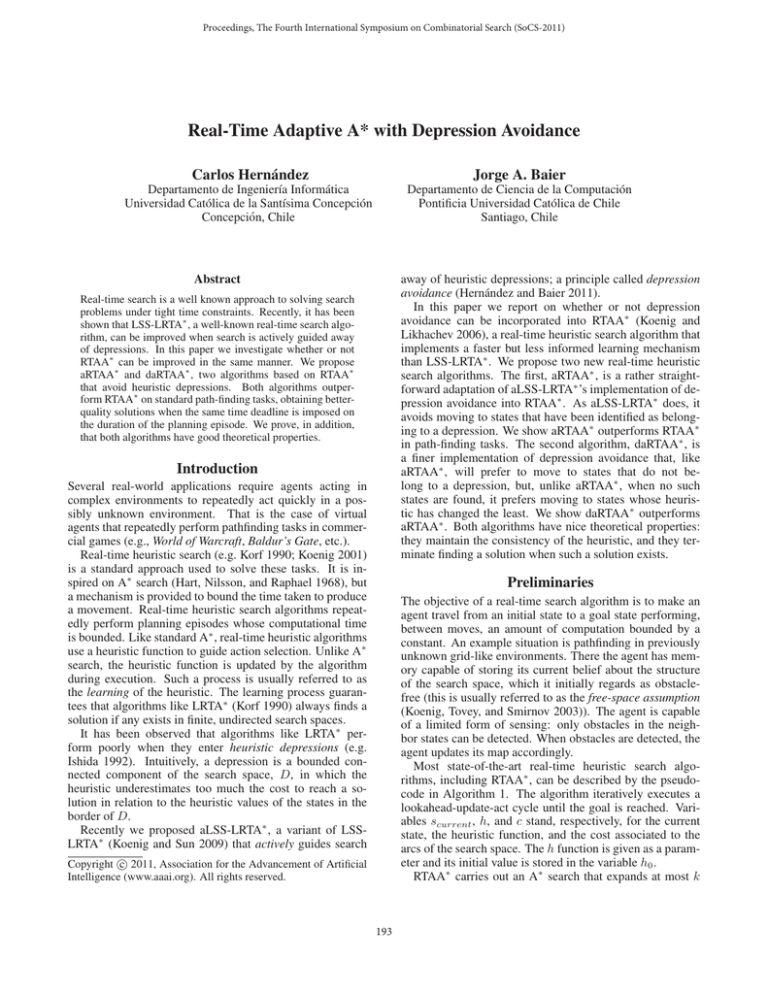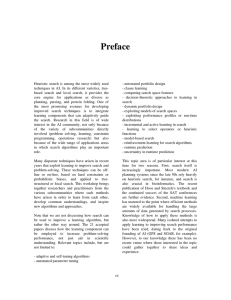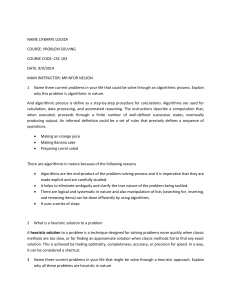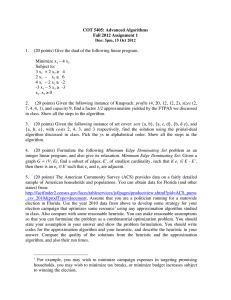
Proceedings, The Fourth International Symposium on Combinatorial Search (SoCS-2011)
Real-Time Adaptive A* with Depression Avoidance
Carlos Hernández
Jorge A. Baier
Departamento de Ingenierı́a Informática
Universidad Católica de la Santı́sima Concepción
Concepción, Chile
Departamento de Ciencia de la Computación
Pontificia Universidad Católica de Chile
Santiago, Chile
away of heuristic depressions; a principle called depression
avoidance (Hernández and Baier 2011).
In this paper we report on whether or not depression
avoidance can be incorporated into RTAA∗ (Koenig and
Likhachev 2006), a real-time heuristic search algorithm that
implements a faster but less informed learning mechanism
than LSS-LRTA∗ . We propose two new real-time heuristic
search algorithms. The first, aRTAA∗ , is a rather straightforward adaptation of aLSS-LRTA∗ ’s implementation of depression avoidance into RTAA∗ . As aLSS-LRTA∗ does, it
avoids moving to states that have been identified as belonging to a depression. We show aRTAA∗ outperforms RTAA∗
in path-finding tasks. The second algorithm, daRTAA∗ , is
a finer implementation of depression avoidance that, like
aRTAA∗ , will prefer to move to states that do not belong to a depression, but, unlike aRTAA∗ , when no such
states are found, it prefers moving to states whose heuristic has changed the least. We show daRTAA∗ outperforms
aRTAA∗ . Both algorithms have nice theoretical properties:
they maintain the consistency of the heuristic, and they terminate finding a solution when such a solution exists.
Abstract
Real-time search is a well known approach to solving search
problems under tight time constraints. Recently, it has been
shown that LSS-LRTA∗ , a well-known real-time search algorithm, can be improved when search is actively guided away
of depressions. In this paper we investigate whether or not
RTAA∗ can be improved in the same manner. We propose
aRTAA∗ and daRTAA∗ , two algorithms based on RTAA∗
that avoid heuristic depressions. Both algorithms outperform RTAA∗ on standard path-finding tasks, obtaining betterquality solutions when the same time deadline is imposed on
the duration of the planning episode. We prove, in addition,
that both algorithms have good theoretical properties.
Introduction
Several real-world applications require agents acting in
complex environments to repeatedly act quickly in a possibly unknown environment. That is the case of virtual
agents that repeatedly perform pathfinding tasks in commercial games (e.g., World of Warcraft, Baldur’s Gate, etc.).
Real-time heuristic search (e.g. Korf 1990; Koenig 2001)
is a standard approach used to solve these tasks. It is inspired on A∗ search (Hart, Nilsson, and Raphael 1968), but
a mechanism is provided to bound the time taken to produce
a movement. Real-time heuristic search algorithms repeatedly perform planning episodes whose computational time
is bounded. Like standard A∗ , real-time heuristic algorithms
use a heuristic function to guide action selection. Unlike A∗
search, the heuristic function is updated by the algorithm
during execution. Such a process is usually referred to as
the learning of the heuristic. The learning process guarantees that algorithms like LRTA∗ (Korf 1990) always finds a
solution if any exists in finite, undirected search spaces.
It has been observed that algorithms like LRTA∗ perform poorly when they enter heuristic depressions (e.g.
Ishida 1992). Intuitively, a depression is a bounded connected component of the search space, D, in which the
heuristic underestimates too much the cost to reach a solution in relation to the heuristic values of the states in the
border of D.
Recently we proposed aLSS-LRTA∗ , a variant of LSSLRTA∗ (Koenig and Sun 2009) that actively guides search
Preliminaries
The objective of a real-time search algorithm is to make an
agent travel from an initial state to a goal state performing,
between moves, an amount of computation bounded by a
constant. An example situation is pathfinding in previously
unknown grid-like environments. There the agent has memory capable of storing its current belief about the structure
of the search space, which it initially regards as obstaclefree (this is usually referred to as the free-space assumption
(Koenig, Tovey, and Smirnov 2003)). The agent is capable
of a limited form of sensing: only obstacles in the neighbor states can be detected. When obstacles are detected, the
agent updates its map accordingly.
Most state-of-the-art real-time heuristic search algorithms, including RTAA∗ , can be described by the pseudocode in Algorithm 1. The algorithm iteratively executes a
lookahead-update-act cycle until the goal is reached. Variables scurrent , h, and c stand, respectively, for the current
state, the heuristic function, and the cost associated to the
arcs of the search space. The h function is given as a parameter and its initial value is stored in the variable h0 .
RTAA∗ carries out an A∗ search that expands at most k
c 2011, Association for the Advancement of Artificial
Copyright Intelligence (www.aaai.org). All rights reserved.
193
Algorithm 1: A real-time heuristic search algorithm
Input: A search space S, a set of goal states G, a heuristic function h,
a cost function c.
1 for each s ∈ S do
2
h0 (s) ← h(s)
3 scurrent ← s0
4 while scurrent ∈ G do
5
LookAhead ()
6
if Open = ∅ then return no-solution
7
snext ← Extract-Best-State()
8
Update ()
9
move the agent from scurrent to snext through the path
10
11
identified by LookAhead. Stop if an action cost along the path
is updated.
scurrent ← current agent position
update action costs (if they have increased)
k
Solution
Cost
1
7
25
97
553,152
197,781
56,989
15,422
1
7
25
97
432,806
146,724
45,336
13,099
1
7
25
97
50,906
28,932
14,116
6,397
# Planning
Episodes
Time per
Episode
RTAA∗
510,579
0.0004
107,321
0.0016
16,606
0.0055
2,632
0.0214
aRTAA∗
399,603
0.0005
80,528
0.0021
13,660
0.0065
2,362
0.0231
daRTAA∗
47,836
0.0005
22,564
0.0023
8,393
0.0082
2,279
0.0263
Time
Percolations
per episode
183.4
174.7
90.9
56.4
5.7
39.9
198.3
992.4
197.0
170.0
88.2
54.6
9.0
61.3
244.7
1,071.1
19.5
51.3
69.1
59.8
9.1
90.8
351.9
1,265.0
Figure 1: The table presents average solution cost, number of
planning episodes, time per planning episode in milliseconds, total
search time in milliseconds, and number of heap percolations per
planning episode for 6,000 path-planning tasks and 4 lookahead
values (k). We performed our experiments on a Linux PC with a
Pentium QuadCore 2.33 GHz CPU and 8 GB RAM.
states in the lookahead phase (Line 5). The variable Open
(cf. Line 6) contains A∗ ’s search frontier. Also, we assume
that after executing an A∗ lookahead, the variable Closed
contains the states that were expanded by the algorithm. Finally, the next state to move to, snext , is assigned in Line 7.
In RTAA∗ , the Extract-Best-State procedure returns
the state with lowest f -value in Open. Finally, the update
procedure updates the h-value of the states in Closed using
the f -value of the snext state (for more details, refer to the
original paper).
Experimental Evaluation
We compared RTAA∗ , aRTAA∗ and daRTAA∗ at solving
real-time navigation problems in unknown environments.
We used 12 video games maps for the experiments. The first
six are taken from the game Dragon Age; the remaining six
are taken from the game StarCraft. We average our experimental results over 6,000 test cases (500 test cases for each
game map). A summary of the results is shown in Figure 1.
We observe that in terms of solution cost, for all lookahead
values, aRTAA∗ consistently outperforms RTAA∗ ; moreover, daRTAA∗ consistently outperforms aRTAA∗ . In addition, daRTAA∗ ’s more refined mechanism for escaping depressions is better than that of aRTAA∗ . For small values for
the lookahead parameter, daRTAA∗ obtains better solutions
than aRTAA∗ used with a much larger lookahead. daRTAA∗
needs only a lookahead parameter of 25 to obtain solutions
better than RTAA∗ with lookahead parameter of 97. With
those values, daRTAA∗ requires about 2.6 times less time
per planning episode than RTAA∗ .
RTAA* with Depression Avoidance
We implemented depression avoidance into RTAA∗ in two
different ways, producing two new algorithms.
aRTAA∗ aRTAA∗ is a straightforward port of aLSSLRTA∗ ’s implementation of depression avoidance into
RTAA∗ . RTAA∗ is modified as follows. First, its update
procedure implements the same update rule of RTAA∗ but,
like aLSS-LRTA∗ , it marks states that have been updated.
Second, RTAA∗ ’s Extract-Best-State procedure returns the state with lowest f -value that is not marked, if such
a state exists; otherwise, it returns the state with lowest f value, just as RTAA∗ would do. As a result aRTAA∗ is a
version of RTAA∗ that avoids depressions using the same
mechanism that aLSS-LRTA∗ utilizes.
References
daRTAA∗ daRTAA∗ is based on aRTAA∗ , but differs from
it in the strategy used to select the next state to move to.
daRTAA∗ will attempt to escape the depression by choosing
the state with best f -value among the states whose heuristic has changed the least. More formally, let L contain
each state s in Open such that there is no other s in Open
such that h(s ) − h0 (s ) < h(s) − h0 (s). daRTAA∗ ’s
Extract-Best-State procedure returns the state with
least f -value from L. On the other hand, daRTAA∗ ’s update
procedure is the same used by RTAA∗ .
Hart, P. E.; Nilsson, N.; and Raphael, B. 1968. A formal basis for
the heuristic determination of minimal cost paths. IEEE Transactions on Systems Science and Cybernetics 4(2).
Hernández, C., and Baier, J. A. 2011. Real-time heuristic search
with depression avoidance. In IJCAI.
Ishida, T. 1992. Moving target search with intelligence. In AAAI,
525–532.
Koenig, S., and Likhachev, M. 2006. Real-time adaptive A*. In
AAMAS, 281–288.
Koenig, S., and Sun, X. 2009. Comparing real-time and incremental heuristic search for real-time situated agents. Autonomous
Agents and Multi-Agent Systems 18(3):313–341.
Koenig, S.; Tovey, C. A.; and Smirnov, Y. V. 2003. Performance
bounds for planning in unknown terrain. AIJ 147(1-2):253–279.
Koenig, S. 2001. Agent-centered search. AI Mag. 22(4):109–131.
Korf, R. E. 1990. Real-time heuristic search. AIJ 42(2-3):189–211.
Properties We have proven that if h is initially consistent,
then it remains consistent throughout an execution of any of
daRTAA∗ or aRTAA∗ . In addition, in finite undirected state
spaces, both algorithms will find a solution if it exists. Finally, after running a finite number of trials, both daRTAA∗
and aRTAA∗ will converge to an optimal solution.
194









